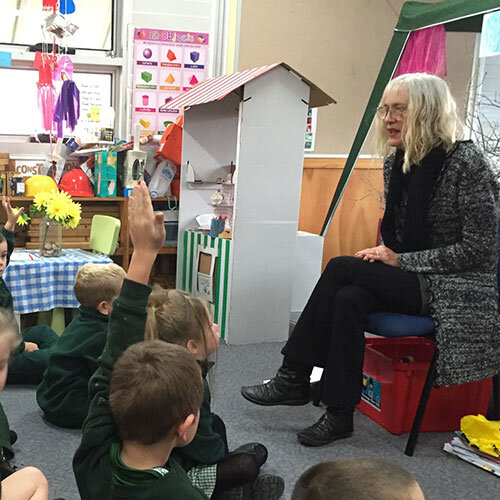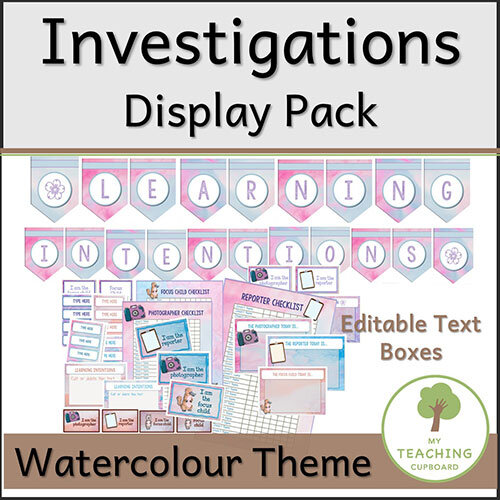How To Run A Tuning-in Session
The tuning-in session is an important part of the play-based classroom's daily morning routine. It is a 15 to 20 minute designated time used to focus on the current learning intentions, build relationships with the focus children, set photographer and reporter tasks and also model and scaffold desired learning outcomes.
A tuning-in session is the perfect way to start the school day. It helps students focus on the learning objectives for the day ahead. If you want your students to be focused on their learning and have a productive and purposeful day, you need to start the day with a tuning-in session.
Linking to the Learning Intentions
We begin our tuning-in session by first referring to our current learning intentions. Our learning intentions are displayed on a notice board close by at the front of the room. They should be in a prominent place so you can refer to them regularly throughout the day. Parents are encouraged to review our learning intentions so having them close to the door is beneficial.
Students who regularly discuss and are made aware of their learning intentions are more focused, motivated and active in their learning. They are also more likely to take responsibility for their own learning.
In kindergarten or prep, I have found my written learning intentions had little effect. Afterall, these children are not confident readers yet so when I referred to the written learning intentions, all they saw were difficult words to read. That’s why I created illustrated learning intentions.
I made a set of age-appropriate learning intentions. Each one has a pictorial representation to help students remember and understand their learning goals. Check out the full set of Foundation Stage Learning Intentions here.
The learning intentions should be discussed with reference to investigation areas and explicit teaching lessons coming up later in the day. Linking them this way helps the children see a purpose to the investigation areas and to their lessons. Just reading through the current learning intentions has very little effect.
Sometimes new investigation areas have been set up or existing areas have been modified. It is important to take the opportunity during the tuning-in session to discuss any new provocations. Always link these new additions back to the curriculum and the current learning intentions.
Some investigation spaces and the resources in them require instructions on how to use them correctly and safely. Setting expectations by scaffolding the intentions and modelling the expected use of new materials and spaces will help to ensure children work purposefully and use the resources respectfully.
Explaining why certain investigation areas or resources have been offered and how they in turn relate to a certain child’s interest or specific learning intention is often overlooked by teachers. Explaining your intent and reasons for offering particular resources or spaces will give the children concrete links to the curriculum.
To optimise engagement or bring attention to a specific learning intention, introduce a prop or hook to spark interest. A special book from the library or a new educational resource can be enough to stimulate interest and encourage children to explore current learning intentions or dying investigation areas.
Again, I will discuss and model expectations around using the resource and explain why it is being introduced. Requesting a child to place the new resource at the designated investigation area carefully will ensure it is ready to go when the session starts and save me a bit of time later.
Finally, when linking to the learning intentions, briefly remind the children about topics discussed during reflection time the previous day. Discussing interesting investigations children did the day before or reminding them about problems that were encountered and solutions discovered, will help them build on their learning from the previous day.
These discussions can be linked to the current learning intentions and are important. They can stimulate prior knowledge in the children and remind them of works in progress and explorations they had not finished the day before.
Products to Help You Run Classroom Investigations
You might be interested in a few products to help you display and organise your investigation routines. There are some classroom display packs available in my store. There are 3 different themes and they are editable so you can easily personalise the pages before printing. The packs include a Learning Intentions banner, mini-posters, checklists, and badges.
Introduce the Focus Children
A brief conversation with each focus child is also an important part of the tuning-in session. The purpose of each conversation is to build a relationship with that child. Learning intentions have already been discussed and will be discussed again at the end of the tuning-in session and then again at the reflection time following investigations. This part of the tuning-in session is time for focusing on a particular child – the focus child. Use this time to get to know your focus child a little better.
Children usually love being the focus child. It makes them feel special and helps to build a classroom community too. Every child in the class has a turn to be the focus child once a fortnight. Depending on the number of children in my class, I will have 2 or 3 focus children each day.
A timetable chart can be displayed in the room so children know when they will have their turn. A timetable can also help you prepare for their special day. There are editable timetables in my FREE Resource Library HERE.
Later in the day, I will listen to the focus children read, check their writing development and numeracy concepts, and help them assess and set relevant personal learning goals. Having focus children ensures I keep track of every child and nobody falls through the cracks.
During this part of the tuning-in session, the focus child usually sits at the front of the room next to me. His peers can be involved in the conversation but sometimes they need reminding this time is not to focus on them. A gentle reminder that they will get a turn to be a focus child is usually all that is required to keep the conversation centered around the focus child.
Topics for the conversation can include the child’s learning goals but I usually focus the discussion around the child’s interests and personal life. I am interested in how they are feeling, things they are proud of, worries they might have along with their favourite animals or colours.
I like to find out what they do on the weekend, how many people are in their family and if they are happy at school. This information can then help to inform assessment and planning along with possible investigation areas to set up.
Towards the end of the conversation, it is a good idea to ask the focus child where they plan to work during the investigation time. Finding out why they plan to work there and what they plan to do helps the teacher learn a little more and helps the child set an intention for their learning. Their responses also let me know where to find them once investigations start.
During investigation time, one of the teacher’s roles is to observe and sometimes work with each focus child, so knowing where to find them will save a little searching time.
When the conversation is finished, the focus child sits over to the side of the carpet space. The focus children are the first to leave the carpet when investigation time starts.
Photographer & Reporter
Photographer and reporter tasks are set during this tuning-in time too. The tasks for the photographer and reporter children are always linked to the curriculum learning intentions.
There is an ideal opportunity for the teacher to model or scaffold learning intentions during this time. Using the photographer and reporter tasks to consolidate concepts or introduce new skills is a good teaching strategy and can be done if time allows.
If you would like to learn more about these roles, I have a detailed blog post on the photographer role and another on the reporter role.
The reporter and photographer sit with the focus children to the side of the carpet area and are also the first to leave when investigation time starts.
Starting Investigations
The children should be dismissed from the meeting area one at a time. This will ensure the children leave the carpet space and start their investigations with purpose and intention. It helps to ask each of the children where they will be working that day. Sometimes further clarification around their intentions for this learning time and possible goals they may be working on can also individually be discussed.
Implementing an intentional dispersal not only stops a chaotic rush to preferred areas, but it also demonstrates expectations that investigation time is a purposeful learning time and not a free-for-all session.
Ensure the order of children dismissed each day is regularly changed so that different children are leaving the carpet space first each day. You do not want to have the same children waiting till the end of dismissal day after day and missing out on desirable spaces.
At the beginning of the year and randomly throughout the year, I will record where each child intends to work, who they are working with and what their intention in the session might be. This information is valuable in understanding the children and their development. This useful information can be used to inform assessments and planning.
When everyone has started their investigations and settled into their work, I check-in with the photographer and reporter first. When I am satisfied they both understand their tasks and I am confident they will provide us with useful documentation, I find the focus children to work with them. Sometimes I just observe and take notes and at other times, I join their explorations taking the opportunity to scaffold their learning.
It is not necessary to follow my sequence when implementing a Tuning-in session. The above sequence is just the order I run our session. It has worked well for us, but you might prefer a different sequence.
Photographer and reporter tasks could be designated at the beginning of the session when the learning intentions are discussed. The reason I prefer to set these tasks at the end of the session is because it gives me 2 shots at addressing our learning intentions within the tuning-in session.
Don’t forget to check out the blog posts on the Photographer Child and the Reporter Child. These roles really help to get the kids invested in their learning. The Photographer and Reporter roles really help to make our investigative learning sessions purposeful.
Tuning-in is one of my favourite parts of the day. It is educational, quick and to the point and such a great way to build relationships and build a sense of classroom community.

















